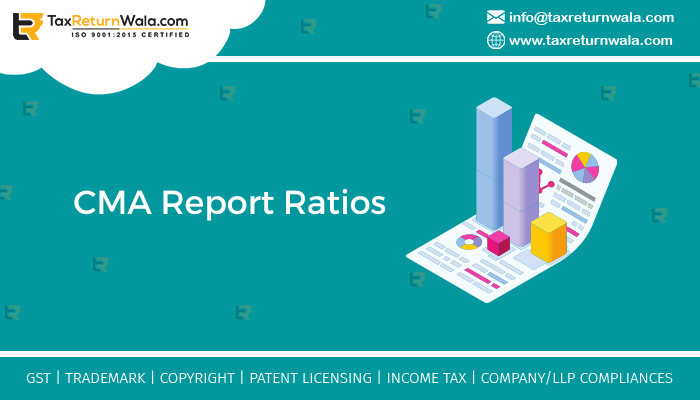List of Ratios used for Preparing CMA (Credit Monitoring Arrangement Report) – CMA Report Ratios
CMA Report Ratios Analysis – Along with managing a business unit, keeping it financially strong and stable is also among the key responsibilities of an entrepreneur. If seen, now instead of taking a loan or credit from any private source entrepreneurs prefer to look for institutional lending. Where formalities are concerned, Institutions like Banks, NBFCs (Non-banking financial corporations), and statutory banking units are much more active towards business lending and developing lending offers with their least know-how. The only document which is asked on a priority from any borrower for lending approval is its business CMA Report.
CMA Report is one of the crucial documents that lending institutions consider to decide whether to lend to the applicant or not. Any company, factory, or business arrangement which requires a loan from banks or any institution has to suffice CMA Report to make them understand their business, its financial soundness, and the flow of funds in and out of the unit.
For in-depth analysis for credit approval, institutions compare different ratios provided in the report. To help you know more about What CMA Report Ratios are? And how to compute different ratios for CMA Report Preparation, we have crafted this article for you.
What is Ratio Analysis for CMA Reporting?
Ratios are used to compare different values, to make them understandable and presentable. While preparing CMA Report, a separate section is provided for the Ratio analysis where different financial ratios stating the performance of the business with the previous year’s values compared with the last few years’ values are disclosed. This comparison is necessary to conclude whether a business is outperforming or underperforming.
Lending / Banking / Credit institutions use these ratios to know the financial stability and the net worth of a business before lending any funds required by it.
List of Ratios used in CMA Report Preparation
Many ratios are important for bankers and financial analysts. Let’s understand some of the fundamental key ratios below:
| RATIOS | OBJECTIVE | FORMULAE | IDEAL RATIO |
| Debt Equity Ratios | It states the proportion of Debt in the Total Capital. Indicates risk-taking capacity in the business
|
Total Debt Total Debt +Equity |
2 to 2.5 |
|
Net Worth to Total assets |
It states the portion of fixed assets out of the total capital of business |
Net Fixed Assets Net Worth (Capital) |
0.5 or lower |
|
Capital Gearing Ratios |
The ratio is a proportion of total equity compared with all fixed cost-bearing funds taken for business |
Equity Fixed Cost Bearing Funds*
* Debt, Preference share capital, loans, etc. |
Higher the ratio, the higher will be the financial risk |
| Debt to Net Worth Ratio | The ratio specifies for total liabilities of the business with the total capital |
Total Liabilities Total Networth |
Positive value of this ratio specifies financial strength |
| Fixed Assets to Long term funds | The ratio compares total assets in business with total liabilities |
Tangible fixed assets long term liabilities |
Higher the better |
| Proprietary Ratio | The ratio check for the portion of owner funds out of total capital in the business |
Shareholder Equity Total Assets or Total Capital
|
Higher the better |
| Interest Coverage Ratio | The ratio checks for the ability of a business to pay off its fixed expenses |
Earning Before Interest and Taxes Interest Expense
|
Higher the better
|
| Debt Service Coverage Ratio | The ratio provides the capacity of the business to pay off its fixed capital cost out of total earnings before interest and taxes of the business |
EBIT Interest + Principal
|
Higher the better |
| Gross Profit Ratio | The ratio states the operating/gross profit out of total expenses and investment in the main operations of a business |
Revenue Less COGSRevenue |
50 to 70% |
| Assets Turnover | The asset turnover ratio compares the capability of the asset to product sales in the business.
|
Net Sales Average Total Assets |
Higher the better |
| Current assets Ratios | The ratio compares the current assets with the current liabilities of the business |
Current Assets Current Liabilities |
1.5 to 3 |
| Quick Ratios | The ratio compares the liquid assets/cash equivalents with the current liabilities.
|
Total Current Assets – Inventory – Prepaid Expenses Current Liabilities |
Higher the better |
| Net Profit Ratios | The ratio compares the net profit out of the total revenue received |
Net Profit Total Revenue |
Higher the better |
| Stock Turnover Ratios | The ratio compares the total cost of goods sold with the average inventory held in stock |
Cost of Goods Sold Average Inventory |
Higher the better |
| Return on Investment | The ratio determines the return received from the total investment made in the business.
|
Net Income Cost of Investment |
7% or more |
CMA Report Ratio analysis is one of the most crucial sections of a CMA Report. Preparation of CMA Reports without proper ratios or limited comparison to ratios limits the chances of entities receiving funding from banks or other financial institutions.
For consultation required on CMA Report preparation or credit assessment of the business, you can talk to our business expert there at
info@taxreturnwala.com


